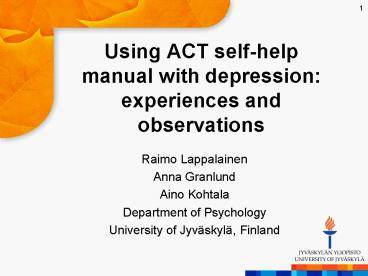Using ACT self-help manual with depression: experiences and observations - PowerPoint PPT Presentation
1 / 18
Title:
Using ACT self-help manual with depression: experiences and observations
Description:
Using ACT self-help manual with depression: experiences and observations Raimo Lappalainen Anna Granlund Aino Kohtala Department of Psychology – PowerPoint PPT presentation
Number of Views:89
Avg rating:3.0/5.0
Title: Using ACT self-help manual with depression: experiences and observations
1
Using ACT self-help manual with depression
experiences and observations
- Raimo Lappalainen
- Anna Granlund
- Aino Kohtala
- Department of Psychology
- University of Jyväskylä, Finland
1
2
Introduction
- Depression is one of the most common
psychological problems. In Finland, the
prevalence of at least moderate depressive
episodes within the last 12 months is about 4
among men, and 8 among women. - Overall, to our knowledge, few studies have
examined the effects of brief interventions
delivered by novice therapists using self-help
manuals
3
The aim
- The purpose of this study was to increase our
knowledge of using self-help manuals in brief ACT
interventions delivered by psychology students.
4
Method
- Clients
- Newspaper advertisement 59 contacted the clinic
? 44 interviewed by phone - 36 started, 30 completed to Post-measurements
- Criterias
- Self-reported mood problems
- No other treatments
2.11.2013
4
anna.a.granlund_at_jyu.fi
5
Method
- 30 subjects reporting depressive symptoms were
treated either by 6-week ACT treatment alone or
with 6-week ACT treatment combined with self-help
manual (Get Out of Your Mind).
6
The self-help manual
- Get Out of Your Mind Into Your Life
- Steven C. Hayes Spencer Smith (2009)
- Translated into Finnish
6
7
Clients (n30)
- Women 21 (70 ), men 9 (30 )
- Age mean 49 years
- No psychiatric diagnoses 60
- Depression diagnoses 27
- No prior psychotherapy 70
- No medication for depression 73
8
The therapists
- N 15 masters level psychology students
(women/men 14/1) - Mean age 25-years (SD4.20 vaihteluväli 2237)
- Mean time for psychology studies 4.13 SD1.06
range 26) - Training CBT 10 hours, ACT 14 hours
- Manual in ACT (Lappalainen ym., 2009 including 32
metaphors ja 18 exercises) - Supervision every week
9
Intervention
- Case formulation, value work, exercises, for
example, mindfulness exercises, the observer
exercise, metaphoras (during every session), home
work - Student therapist treated one client with the
manual and one without - The therapists in the manual group were
instructed to use three Chapters Introduction,
Human Suffering and What Are Values? - Rest of the manual was used individually
9
10
Method
- Pre-Post measurements presented
- Time between Pre-Post 6-8 weeks
- Therapists recorded after every session if they
had worked with a particular ACT core prosess
11
Results
- Both treatments showed significant symptom
improvement. But there were no clear differences
between the groups. - The majority of the students reported that the
manual is useful part of the treatment, but only
about half of the students estimated that the
client had benefitted of the manual.
12
Pre-Post Pre-Post Pre-Post Pre-Post Pre-Post
ACTManual (n14) ACTManual (n14) ACT (n16) ACT (n16)
Pre Post Pre Post
BDI 22.79 (8.07) 10.64 (6.73) 19.75 (8.40) 7.88 (6.29)
AAQ-II 34.86 (9.02) 45.21 (11.80) 40.19 (7.80) 50.87 (10.21)
KIMS 113.00 (9.59) 122.79 (15.05) 117.56 (13.45) 130.12 (11.81)
BAI 16.21 (8.75) 11.86 (10.28) 13.94 (9.13) 7.81 (6.86)
SCL-90 1.17 (0.41) 0.71 (0.42) 1.01 (0.47) 0.47 (0.36)
Social funct 32.29 (7.26) 36.57 (7.15) 33.81 (7.98) 41.38 (7.30)
SelfConfid 46.14 (15.02) 55.21 (17.34) 55.53 (14.53) 71.13 (16.03)
Satisfaction 39.71 (14.90) 57.00 (18.32) 51.07 (20.15) 70.47 (18.60)
Mood 32.93 (13.29) 53.79 (19.39) 43.19 (21.67) 64.19 (19.51)
plt .001, p lt.01, p lt.05 plt .001, p lt.01, p lt.05 plt .001, p lt.01, p lt.05 plt .001, p lt.01, p lt.05 plt .001, p lt.01, p lt.05
12
13
Depression (BDI) change over time
ACT
ACTManual
14
Relationships between treatment change and ACT
core processes
- In the ACTmanual group the change in depression
scores during the treatment correlated
significantly (? .73) with how often
mindfulness skills had been addressed - The change in anxiety level was correlated with
how often defusion skills had been addressed (?
.63) - Change in mindfulness skills (KIMS) correlated
with how often being present skills (mindfulness)
had been addressed (? .54) - These relationships were observed in the
ACTmanual group only
15
Use of the manual
- According to the therapists, 43 of the clients
had completed weekly homework assignments from
the manual - 36 had seldom completed homework assignments
- 43 of therapists reported that they had used
the book relatively seldom during the sessions
16
Impact of the manual
- There were 236 pages in the manual
- Of which the clients in the ACTmanual group read
133 pages - Reading the manual was positively associated with
the change in psychological symptoms (? .59,
p0.03), depression (? .50, p0.07), anxiety (?
.51, p0.06), and social functioning (?.68,
p0.01).
17
Experiences of using the manual
- 88 of the clients felt that the manual had been
a useful part of their treatment - 86 of the therapists reported that practical
therapy worked better with the manual than
without it - Clients were able to study once more topics
addressed in sessions, but the manual also gave
support to the therapists - Those clients who actually had used the manual
actively were also satisfied with it
18
Conclusions
- In general, 40-50 of the clients and of the
student therapist used the manual actively during
the treatment. - Active manual use was associated with better
treatment outcome - There were some indications that the processes of
change were different when the manual was used or
the therapists observed the core processes
differently - This study suggests that Masters level
psychology students and their clients may benefit
of the use of the manual, but use should be
planned carefully































